Student Researchers Explore Topics of Local Importance
By Rebecca GoldfineThree biology majors this summer are working on research about eelgrass, lobsters, and a river dam. Each project has the potential to positively impact Maine’s environment.
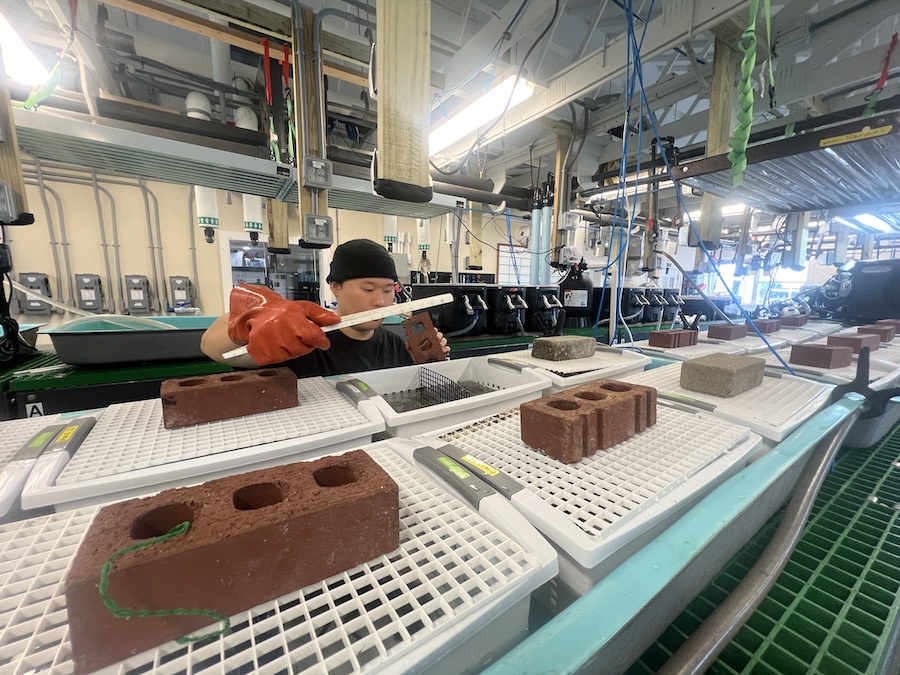
Lucy Dutton ’25 and Danny Lee ’25, who are based at the Schiller Coastal Studies Center, are investigating lobster bait and eelgrass germination, which have significant economic and environmental significance to Maine. Zellie Lipman ’26 is looking into impacts of the Brunswick Dam on the Androscoggin River, with repercussions for fish populations and energy production.
Bowdoin students are often drawn to research that matters to local people, said Holly Parker, director of the Schiller Coastal Studies Center. “The work that Danny and Lucy are doing is tied into issues being faced in our communities,” she said. “Students want to make a difference right now. They’re impatient, in a good way.”
She added that Schiller Coastal Studies Center, located on Harpswell Bay, is ideally positioned in a working waterfront community to build partnerships with the fishing industry, nonprofits, government agencies, and other researchers to “identify and explore the challenges facing both our marine and coastal environments and the people whose livelihoods depend on their health.”
“Giving back to our immediate environment is important to us,” she said. At the same time, “We’re asking questions that are hyper-local but are being asked all over the world.”
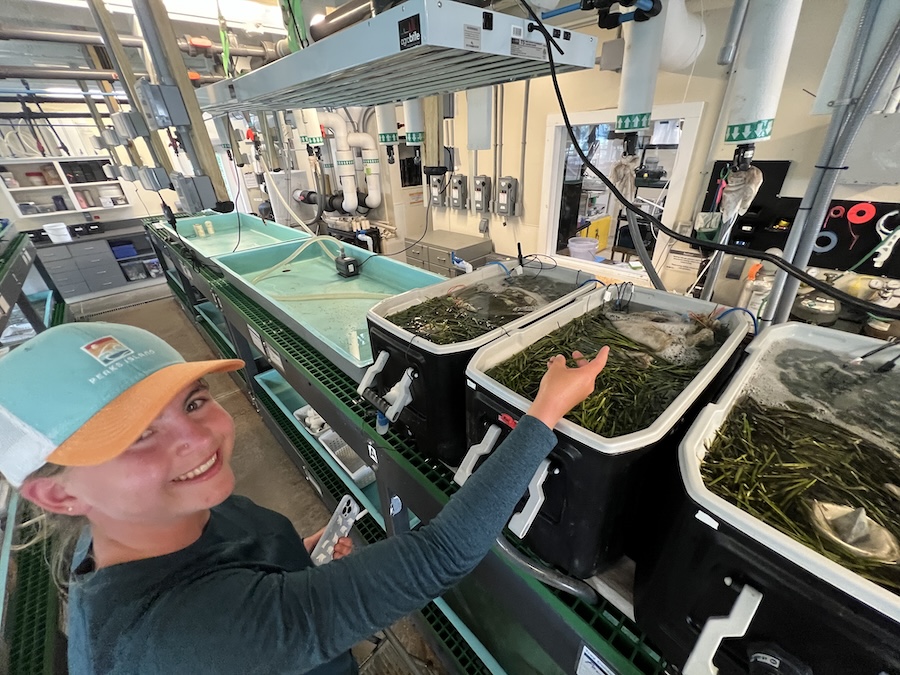
Lucy Dutton ’25 Builds Maine's First Eelgrass Seed Bank
In six tanks in the Schiller lab, more than a thousand eelgrass shoots bubble gently, like ingredients in a healthy soup.
Dutton collected the spears during scuba dives in Casco Bay (she got certified last summer). In about four to six weeks, the shoots will drop their seeds, allowing her to scoop up the small oval kernels to preserve in her refrigerated bank.
Eelgrass, also known as seagrass (or Zostera marina), grows in shallow areas along the shore, helping to prevent coastal erosion and to sequester excess carbon dioxide. Meadows of the long grass (which is actually a flowering plant) provide a safe shelter for juvenile shellfish—including lobster, oysters, and clams—and other species like cod. But a warming Gulf of Maine and destruction from the invasive green crab have halved the amount growing in Casco Bay in just the past five years.
The disappearance of the vital marine plant has spurred a large collaboration of conservation and research organizations, along with the Maine Department of Environmental Protection, to experiment with restoration efforts in southern Maine.
Dutton received a funded internship from Career Exploration and Development (CXD) this summer to work with a leading partner in this effort called Team Zostera. Dutton's particular role is focused on science: she first helped to identify the best sites to collect eelgrass and now is setting up the seed bank. Her next step is to study seed viability and germination, a project that will evolve into a yearlong honors thesis.
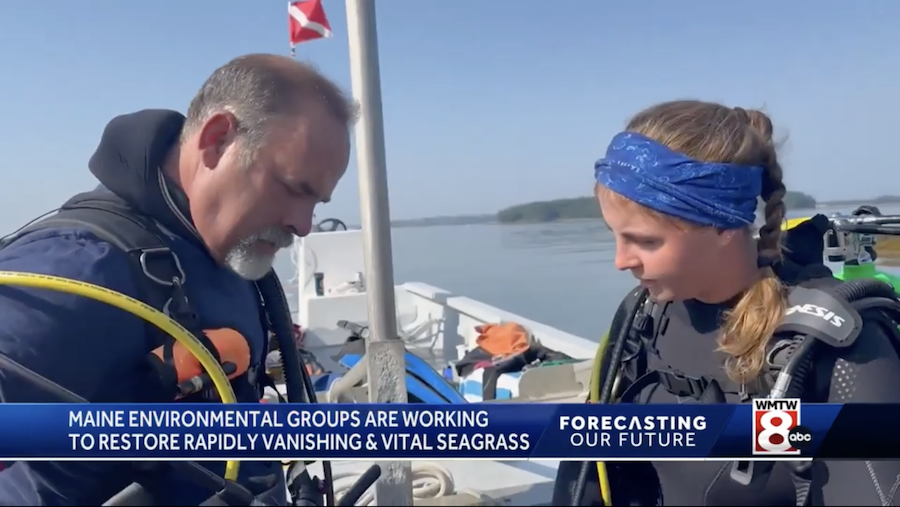
Some of her seeds will be used in a pilot restoration project in Casco Bay later this year; others will be sent to restoration efforts down the Eastern Seaboard. Though the newly planted meadows might still be weakened by climate change and green crabs, “eelgrass meadows are volatile and constantly shifting location and health each year,” Dutton explained. “The stressors on the meadows will change, and it is worth attempting to help the meadows return.”
The remainder of seeds will be used in her research. She plans to test different ways to determine whether the seeds are alive and how likely they are to sprout, and she will also assess the hardiness of seeds under different conditions by adjusting temperature, salinity, or oxygen.
While Dutton is set on pursuing a PhD in marine science after graduating from Bowdoin, she is not yet sure what area she wants to specialize in. Besides eelgrass, she has worked on another long-term research project at Bowdoin, on microplastics. Both subjects satisfied her interest in public service.
“I want to work on the kind of science that can make a direct impact on people or the environment, a positive impact,” she said. “I am interested in doing something that will save a species or help a habitat.”
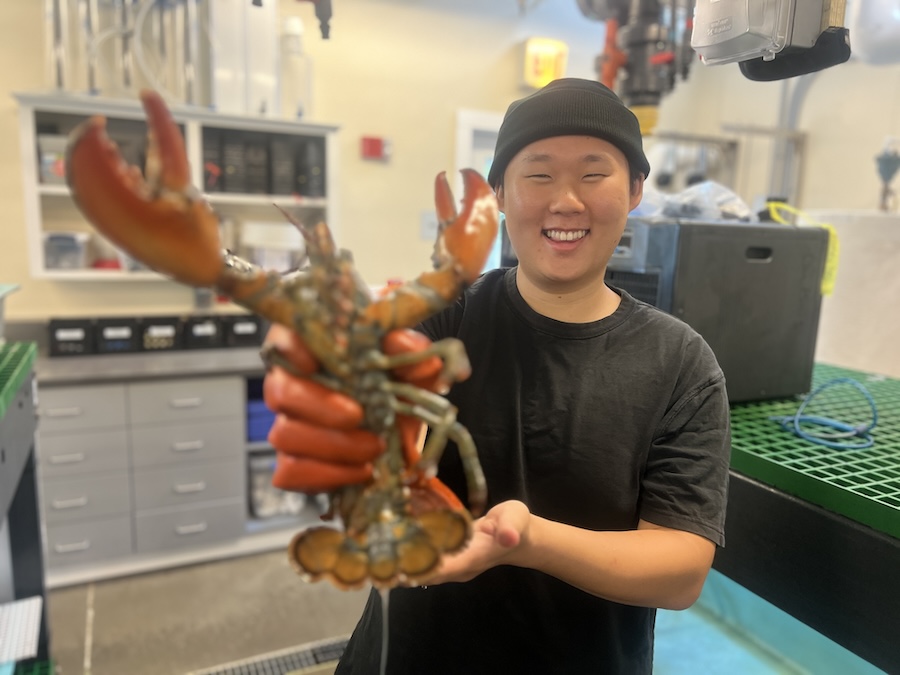
Danny Lee ’25 Studies the Physiological Effects on Lobster of Eating Pork Hide
Last fall, when Lee was a student in the Bowdoin Coastal Studies Semester program, he watched a lobster trap demonstration in which the fisherman used pork hide as bait.
“I was like, ‘What the heck? What is this?’” he recounted. Lobsters have not evolved to digest pork hide, which is also not a nutritionally dense food, Lee explained. He became curious to see how lobsters fared on this alien diet, and set up a short-term experiment last fall. “It turns out pork was really bad,” he said. The lobsters that were fed only pork hide became very lethargic. One died.
As traditional bait sources like herring become harder to come by, pork hide is seen as a cheap and readily available alternative. Consequently, pork hide, which is a mostly unusable byproduct from the meat industry, has become more common in Maine lobster traps.
But there is a dearth of knowledge about the health effects of pork diets on lobsters, according to Lee. After his fall experiment produced alarming results, Lee and his advisors decided they had an obligation to conduct more studies and to share their results with the lobster industry.
One of Lee's concerns is that if many traps are filled with pork hide, juvenile lobsters could end up eating a lot of the stuff, harming their development.
This summer, Lee expanded his study to test 100 lobsters, ranging in size from small to large. He fed a third of them a pork diet, another third a fish diet, and a third alternated weekly between pork and fish. He is monitoring the lobsters’ heart rates, claw strength, and blood quality, as well as timing how quickly they can right themselves after being flipped over.
After collecting and analyzing this data, he'll write an honors thesis that he'll try to publish and distribute widely. “The working waterfront and the science community don’t always connect, but I am hoping to bridge that gap,” he said. “I hope to raise awareness that using pork hide as bait could be damaging the future stock of lobster.”
But Parker said his attention is already attracting people in the industry. “The Maine lobster is a brand,” she said. “It's the best lobster in the world, and so we want to be very careful about how we treat these animals.”
Growing up in Los Angeles, Lee said he has always been drawn to marine science, and since coming to Bowdoin has immersed himself in the subject. “I’ve had all these opportunities at Bowdoin I never imagined having,” he said. “I feel very privileged and thankful for that.”
The Bowdoin Coastal Studies Semester was especially inspiring, he added. “It let us connect science to the real world and see how that science can be used. It gave me insight into what I can do, for example, like working in aquaculture or the fisheries, or going to grad school and continuing this type of research.”
Faculty advisors: (summer) Jaret Reblin, associate director for science, and (fall) Olaf Ellers, research affiliate in biology and mathematics
Fellowship: Henry L. and Grace Doherty Charitable Foundation Coastal Studies Research Fellowship
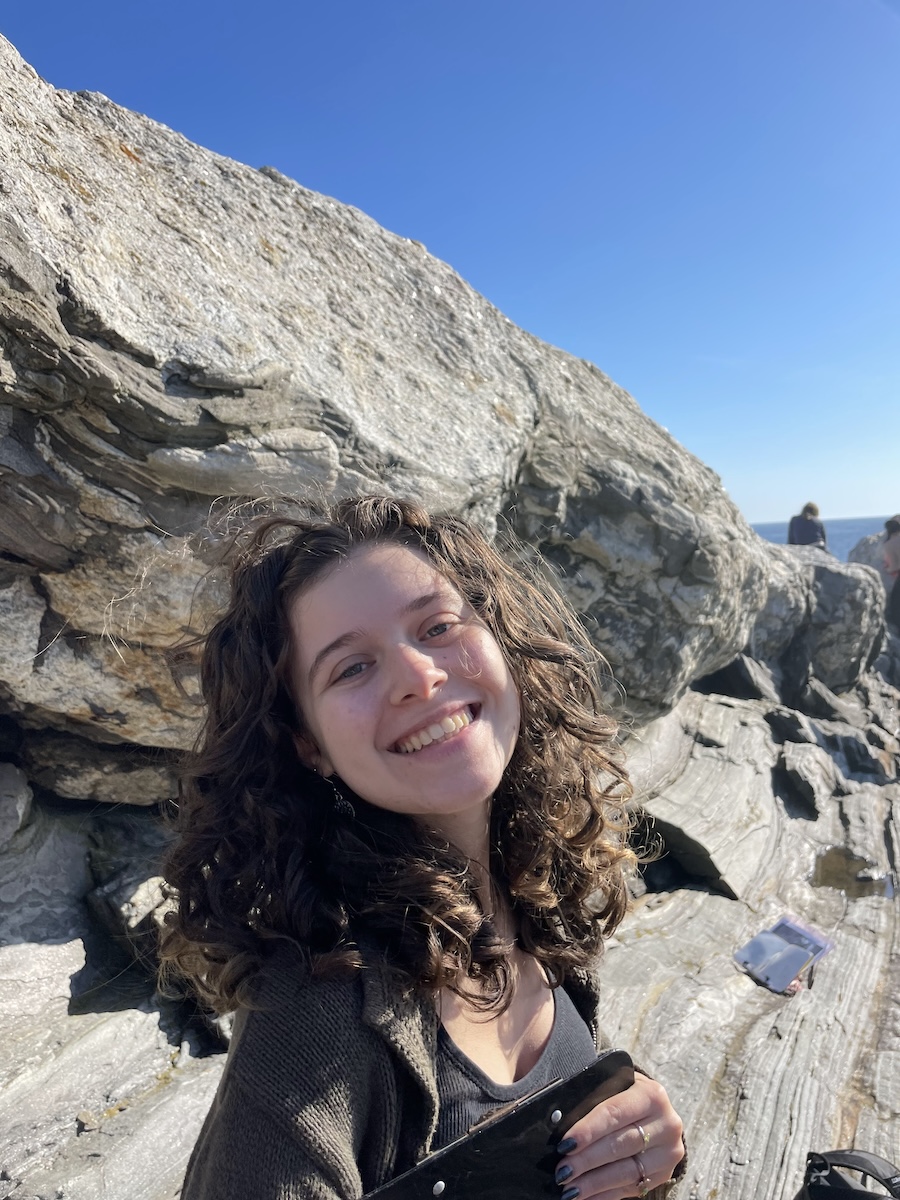
Zellie Lipman ’26 Builds a Community Website and Quantifies Fish Passage Data for a Dam Recertification
Lipman is playing a central role in a network of stakeholders who want to better understand the Brunswick Dam’s impacts on the Androscoggin River. This summer she’s built a website to present a range of information about the forty-two-year-old dam. She’s also partnering with a retired professor to collect data on the fish that attempt to swim upriver, past the structure, to spawn.
Her work supports a local effort to prepare for upcoming public hearings about the dam's recertification, scheduled for 2029. As the Federal Energy Regulatory Commission (FERC) assesses whether to renew the hydroelectric dam's fifty-year certificate, it will likely consider keeping the dam as it is, suggesting structural changes, or even ordering it be dismantled.
The website presents just facts and science, Lipman said. But she added that so far, a lot of the data “points to the current fish passage as not adequate for fish to get through.”
To learn more about fish passage over the dam, Lipman is working with John Lichter, emeritus professor of biology and environmental studies, on a multi-year project. This summer, they're using a sonar to count the number of fish, mainly American shad, that attempt to swim up the fish ladder. Shad, an anadromous fish species, spends part of its life cycle in the ocean, returning inland to reproduce upriver. (Other anadromous fish include sturgeon and alewives.) Dams can greatly impede this journey and diminish the fish population size, sending ripple effects throughout the food chain.

Lipman said the website includes a history of the dam and its design, a glossary of technical terms, case studies, and data about the Brunswick Dam's effects on fish runs, the regional ecology, the local economy, and the amount of energy it generates. She encourages contributors to submit other relevant information, such as scientific articles, data sets, and news clippings.
Lipman is a biology major with a concentration in ecology, evolution, and marine biology, but she’s also interested in the interdisciplinary work of environment studies. Her project this summer satisfies her interest in both science and community involvement.
“I wasn’t sure how much of an impact the website would have, but people tell me they appreciate the information being all in one place. They’re excited to contribute to the site, and it’s fulfilling to see it get used, and to see it help people in the field.”
She added, “I hope it makes a difference and informs the coming debate with FERC.”
Faculty advisors: Vlad Douhovnikoff, associate professor of biology, and John Lichter, emeritus professor of biology and environmental studies
Fellowship: Hughes Family Summer Research Fellowship